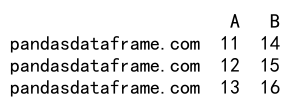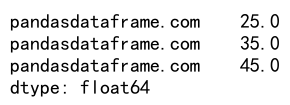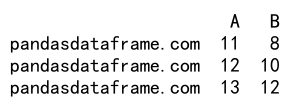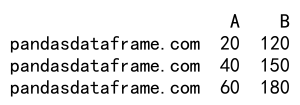Pandas Apply with Arguments
Pandas is a powerful Python library used for data manipulation and analysis. One of its core functionalities is the apply() function, which allows users to apply a function along an axis of the DataFrame or to elements of a Series. This article explores the use of the apply() function with additional arguments, providing a comprehensive guide and multiple examples to demonstrate its versatility and utility.
Introduction to apply()
The apply() function in Pandas can be used on both Series and DataFrame objects. It is highly useful for applying a function to each element in a Series or to a series along a specific axis in a DataFrame. The basic syntax of apply() is:
DataFrame.apply(func, axis=0, args=(), **kwds)
func: The function to apply to each column/row.axis: Axis along which the function is applied.0for applying function to each column,1for each row.args: Tuple of positional arguments to pass to function.**kwds: Additional keyword arguments to pass to function.
Using apply() with Arguments
When using apply(), sometimes the function you want to apply needs additional arguments. You can pass these arguments after the function name in the args parameter as a tuple.
Example 1: Adding a Constant Value to DataFrame Columns
Suppose you want to add a constant value to each element in a DataFrame. Here’s how you can do it using apply() with arguments.
import pandas as pd
def add_constant(x, constant):
return x + constant
df = pd.DataFrame({
'A': [1, 2, 3],
'B': [4, 5, 6]
}, index=['pandasdataframe.com', 'pandasdataframe.com', 'pandasdataframe.com'])
result = df.apply(add_constant, args=(10,))
print(result)
Output:

Example 2: Applying a Function with Multiple Arguments to Rows
You can apply a function that takes multiple arguments to each row in a DataFrame.
import pandas as pd
def process_row(row, multiplier, divisor):
return (row.sum() * multiplier) / divisor
df = pd.DataFrame({
'A': [1, 2, 3],
'B': [4, 5, 6]
}, index=['pandasdataframe.com', 'pandasdataframe.com', 'pandasdataframe.com'])
result = df.apply(process_row, axis=1, args=(10, 2))
print(result)
Output:

Example 3: Modifying DataFrame Based on External Values
Sometimes, you might want to modify a DataFrame based on values that are not within the DataFrame.
import pandas as pd
external_values = {'A': 1, 'B': -1}
def adjust_values(column, adjust_dict):
return column + adjust_dict[column.name]
df = pd.DataFrame({
'A': [1, 2, 3],
'B': [4, 5, 6]
}, index=['pandasdataframe.com', 'pandasdataframe.com', 'pandasdataframe.com'])
result = df.apply(adjust_values, args=(external_values,))
print(result)
Output:

Example 4: Applying Functions Conditionally Across Different Columns
You can apply different functions to different columns of a DataFrame based on certain conditions.
import pandas as pd
def custom_func_A(x, add_value):
return x + add_value
def custom_func_B(x, multiply_value):
return x * multiply_value
df = pd.DataFrame({
'A': [1, 2, 3],
'B': [4, 5, 6]
}, index=['pandasdataframe.com', 'pandasdataframe.com', 'pandasdataframe.com'])
result = pd.DataFrame({
'A': df['A'].apply(custom_func_A, args=(10,)),
'B': df['B'].apply(custom_func_B, args=(2,))
})
print(result)
Output:

Example 5: Dynamic Function Application Based on Column Names
Applying different functions dynamically based on the column names can be achieved using a dictionary to map functions to columns.
import pandas as pd
functions = {
'A': lambda x: x + 10,
'B': lambda x: x * 2
}
df = pd.DataFrame({
'A': [1, 2, 3],
'B': [4, 5, 6]
}, index=['pandasdataframe.com', 'pandasdataframe.com', 'pandasdataframe.com'])
result = df.apply(lambda col: functions[col.name](col))
print(result)
Output:

Example 6: Complex Operations Involving Multiple Columns
Sometimes, the function you want to apply might need to consider multiple columns at once.
import pandas as pd
def complex_operation(row, factor):
return (row['A'] + row['B']) * factor
df = pd.DataFrame({
'A': [10, 20, 30],
'B': [15, 25, 35]
}, index=['pandasdataframe.com', 'pandasdataframe.com', 'pandasdataframe.com'])
result = df.apply(complex_operation, axis=1, args=(2,))
print(result)
Output:

Example 7: Aggregating Data Using apply()
You can use apply() to perform aggregation operations that require additional parameters.
import pandas as pd
def aggregate_data(column, multiplier):
return sum(column) * multiplier
df = pd.DataFrame({
'A': [1, 2, 3],
'B': [4, 5, 6]
}, index=['pandasdataframe.com', 'pandasdataframe.com', 'pandasdataframe.com'])
result = df.apply(aggregate_data, args=(10,))
print(result)
Output:

Example 8: Dynamic Adjustment Based on External Configuration
Using an external configuration, you can dynamically adjust DataFrame values using apply().
import pandas as pd
config = {'A': 2, 'B': 3}
def dynamic_adjustment(x, config):
return x * config[x.name]
df = pd.DataFrame({
'A': [10, 20, 30],
'B': [40, 50, 60]
}, index=['pandasdataframe.com', 'pandasdataframe.com', 'pandasdataframe.com'])
result = df.apply(dynamic_adjustment, args=(config,))
print(result)
Output:

Example 9: Applying a Function to Selective Columns
You can selectively apply a function to specific columns using apply() and passing additional arguments.
import pandas as pd
def increment_if_A(x, increment):
if x.name == 'A':
return x + increment
return x
df = pd.DataFrame({
'A': [1, 2, 3],
'B': [4, 5, 6]
}, index=['pandasdataframe.com', 'pandasdataframe.com', 'pandasdataframe.com'])
result = df.apply(increment_if_A, args=(10,))
print(result)
Output:

Example 10: Complex Row Operations
This example shows how to perform complex operations on rows using multiple arguments.
import pandas as pd
def complex_row_operation(row, factor, subtract):
return (row.sum() * factor) - subtract
df = pd.DataFrame({
'A': [10, 20, 30],
'B': [15, 25, 35]
}, index=['pandasdataframe.com', 'pandasdataframe.com', 'pandasdataframe.com'])
result = df.apply(complex_row_operation, axis=1, args=(2, 5))
print(result)
Output:

Example 11: Using apply() with Lambda Functions
Lambda functions can also be used with apply() to perform quick operations that require additional arguments.
import pandas as pd
df = pd.DataFrame({
'A': [100, 200, 300],
'B': [150, 250, 350]
}, index=['pandasdataframe.com', 'pandasdataframe.com', 'pandasdataframe.com'])
result = df.apply(lambda x: x + 10 if x.name == 'A' else x * 2)
print(result)
Output:

Example 12: Custom Aggregation with External Factors
Finally, this example shows how to perform a custom aggregation that incorporates external factors into the calculation.
import pandas as pd
def custom_aggregation(column, factor, base):
return (column.sum() + base) * factor
df = pd.DataFrame({
'A': [10, 20, 30],
'B': [40, 50, 60]
}, index=['pandasdataframe.com', 'pandasdataframe.com', 'pandasdataframe.com'])
result = df.apply(custom_aggregation, args=(5, 100))
print(result)
Output:

Pandas Apply with Arguments Summary
The apply() function in Pandas is a versatile tool for data manipulation, allowing for complex operations and adjustments based on both internal and external data. By utilizing additional arguments and keyword arguments, you can tailor the function’s behavior to meet specific data processing needs. The examples provided illustrate a range of scenarios where apply() can be effectively used to enhance data analysis workflows.
 Pandas Dataframe
Pandas Dataframe